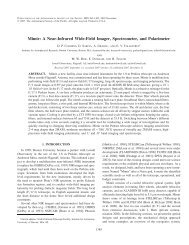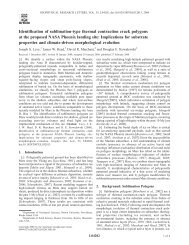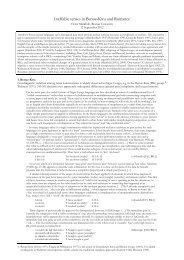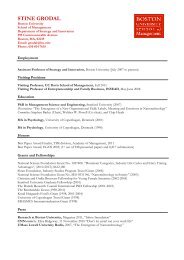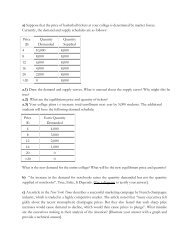Ergin, H. I. <strong>and</strong> F. Gul (2009): “A Theory of Subjective Compound Lotteries,” Journal ofEconomic Theory 144, 899-929.Ghirardato, P., <strong>and</strong> M. Marinacci (2002): “<strong>Ambiguity</strong> Made Precise: A Comparative Foundation,”Journal of Economic Theory 102, 251-289.Gilboa, I., <strong>and</strong> D. Schmeidler (1989): “Maxmin Expected Utility with a Non-Unique Prior,”Journal of Mathematical Economics 18, 141-153.Gul, F., <strong>and</strong> W. Pesendorfer (2004): “Self-Control <strong>and</strong> the Theory of Consumption,” Econometrica72, 119-158.Halevy, Y. (2007): “Ellsberg Revisited: An Experimental Study,” Econometrica 75, 503-536.Hanany, E. <strong>and</strong> P. Klibanoff (2009): “Updating <strong>Ambiguity</strong> Averse Preferences,” B.E. Journalof Theoretical Economics Vol. 9, Issue 1 (Advances), Article 37.Hanany, E. <strong>and</strong> P. Klibanoff (2007): “Updating preferences with multiple priors,” TheoreticalEconomics, 2, 261-298.Hansen, L. P. (2007): “Beliefs, Doubts <strong>and</strong> Learning: The Valuation of MacroeconomicRisk,” American Economic Review 97, 1-30.Hansen, L. P., J. C. Heaton, <strong>and</strong> N. Li (2008): “Consumption Strikes Back?: MeasuringLong-Run Risk,” Journal of Political Economy 116, 260-302.Hansen, Lars Peter <strong>and</strong> Thomas J. Sargent (2010): “Fragile Beliefs <strong>and</strong> the Price of Uncertainty,”Quantitative Economics 1, 129-162.Hansen, L. P. <strong>and</strong> T. J. Sargent (2008): Robustness, Princeton University Press.Hansen, L. P. <strong>and</strong> T. J. Sargent (2007): “Robust Estimation <strong>and</strong> Control without Commitment,”Journal of Economic Theory 136, 1-27.Hansen, L. P. <strong>and</strong> T. J. Sargent (2001): “Robust Control <strong>and</strong> Model Uncertainty,” AmericanEconomic Review 91, 60-66.Hansen, L. P. <strong>and</strong> K. Singleton (1983): “Stochastic Consumption, Risk Aversion, <strong>and</strong> theTemporal Behavior of Asset Returns,” Journal of Political Economy 91, 249-265.Hayashi, T. (2005): “<strong>Intertemporal</strong> <strong>Substitution</strong>, Risk Aversion <strong>and</strong> <strong>Ambiguity</strong> Aversion,”Economic Theory 25, 933-956.Ju, N. <strong>and</strong> J. Miao (2007): “Learning, <strong>Ambiguity</strong>, <strong>and</strong> Asset Returns,” working paper,Boston University.Ju, N. <strong>and</strong> J. Miao (2010): “Learning, <strong>Ambiguity</strong>, <strong>and</strong> Asset Returns,” working paper,Boston University.Klibanoff, P., M. Marinacci <strong>and</strong> S. Mukerji (2005): “A <strong>Smooth</strong> Model of Decision Makingunder <strong>Ambiguity</strong>,” Econometrica 73 (6), 1849-1892.Klibanoff, P., M. Marinacci <strong>and</strong> S. Mukerji (2009a): “<strong>Recursive</strong> <strong>Smooth</strong> <strong>Ambiguity</strong> Preferences,”Journal of Economic Theory 144, 930-976.55
Klibanoff, P., M. Marinacci <strong>and</strong> S. Mukerji (2009b): “On the <strong>Smooth</strong> <strong>Ambiguity</strong> Model: AReply,” working paper, Northwestern University.Klibanoff, P. <strong>and</strong> E. Ozdenoren (2007): “Subjective <strong>Recursive</strong> Expected Utility,” EconomicTheory, 30, 49-87.Koopmans, T. (1960): “Stationary Ordinal Utility <strong>and</strong> Impatience,” Econometrica 28, 287-309.Kreps, D. (1988): Notes on the Theory of Choice, Westview Press.Kreps, D., <strong>and</strong> E.L. Porteus (1978): “Temporal Resolution of Uncertainty <strong>and</strong> DynamicChoice Theory,” Econometrica 46, 185-200.Maccheroni, F., M. Marinacci, <strong>and</strong> A. Rustichini, (2006a): “<strong>Ambiguity</strong> Aversion, Robustness,<strong>and</strong> the Variational Representation of Preferences,” Econometrica 74, 1447-1498.Maccheroni, F., M. Marinacci, <strong>and</strong> A. Rustichini, (2006b): “Dynamic variational preferences,”Journal of Economic Theory 128, 4-44.Marinacci, M. <strong>and</strong> L. Montrucchio (2009): “Unique Solutions for Stochastic <strong>Recursive</strong>Utilities,” forthcoming in Journal of Economic Theory.Mehra, R. <strong>and</strong> E. C. Prescott (1985): “The Equity Premium: A Puzzle,” Journal of MonetaryEconomics 15, 145-161.Nau, R. F. (2006): “Uncertainty Aversion with Second-Order Utilities <strong>and</strong> Probabilities,”Management Science 52, 136-145.Savage, L. (1954), The Foundations of Statistics, New York: Wiley.Schmeidler, D. (1989): “Subjective Probability <strong>and</strong> Expected Utility without Additivity,”Econometrica, 57 (3), 571-87.Segal, U. (1987): “The Ellsberg Paradox <strong>and</strong> Risk Aversion: An Anticipated Utility Approach,”International Economic Review 28, 175-202.Segal, U. (1990): “Two-Stage Lotteries Without the Reduction Axiom,” Econometrica, 58,349-77.Seo, K. (2009): “<strong>Ambiguity</strong> <strong>and</strong> Second-Order Belief,” Econometrica 77, 1575-1605.Siniscalchi, M. (2010): “Dynamic Choice under <strong>Ambiguity</strong>,” forthcoming in TheoreticalEconomics.Skiadas C. (1998): “<strong>Recursive</strong> Utility <strong>and</strong> Preferences for Information,” Economic Theory,12, 293-312.Skiadas C. (2009): Asset Pricing Theory, Princeton, NJ: Princeton University Press.Strzalecki, T. (2009): “Temporal Resolution of Uncertainty <strong>and</strong> <strong>Recursive</strong> Models of <strong>Ambiguity</strong>Aversion,” working paper, Harvard University.Wang, T. (2003): “Conditional Preferences <strong>and</strong> Updating,” Journal of Economic Theory108, 286-321.56
- Page 1:
Intertemporal Substitution andRecur
- Page 6 and 7: As in KMM (2005, 2009a), we impose
- Page 8 and 9: 2. Review of the Atemporal ModelsIn
- Page 10 and 11: defined over it. Notice that by res
- Page 12: For any c ∈ C, we use δ[c] to de
- Page 15: The axiom below states that the pre
- Page 18: is ambiguity averse if he prefers a
- Page 22 and 23: Axiom B6 (Dynamic Consistency) For
- Page 24 and 25: 3. On the subdomain C × M, we obta
- Page 26 and 27: We can similarly define ambiguity l
- Page 28 and 29: epresentations under these two appr
- Page 30 and 31: where R t+1 is the market return fr
- Page 32 and 33: Segal (1987, 1990) and Seo (2009).
- Page 34 and 35: A Appendix: Proof of Theorems 1 and
- Page 36 and 37: Define v = ψ ◦ ū −1 ◦ u, wh
- Page 38 and 39: compute:∫˜ū (m) =∫=∫=∫= A
- Page 40 and 41: DefineH = {h = (h 0 , h 1 , h 2 ,
- Page 42 and 43: Lemma 5 We have the homeomorphic re
- Page 44 and 45: Finite-step-ahead acts and densenes
- Page 46 and 47: which is strictly increasing in the
- Page 48 and 49: where the second equality follows f
- Page 50 and 51: D Appendix: Proofs for Section 4.4P
- Page 52 and 53: This relation holds true because i
- Page 54 and 55: In complete markets, the following
- Page 58: Weil, P. (1989): “The Equity Prem



